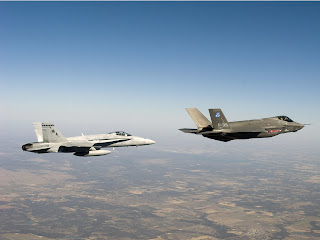 | |
| The present and future? F-18 following a F-35. |
So what does Canada need? It's a big country with not a lot of airbases. That means we need a fast, long range interceptor much like the Avro Arrow. That's easy. Most modern multi-role fighters are capable of matching or exceeding the Arrow's range, the addition of drop tanks and air-to-air refueling make it even less of an issue. Of course, when intercepting a hostile, you need more than range, you need to get to the threat as quickly as possible. For many fighters, this means using afterburners. Unfortunately, afterburners drastically reduce range they also make the jet and easy target for infrared sensors. There are a few jet fighters, however, that are capable of exceeding the speed of sound without using afterburners. This feature, called supercruise, can give fighters like the F-22 Raptor and Eurofighter Typhoon a huge advantage.
 | |
| An F-22 breaking the sound barrier. Notice the lack of afterburners. |
Infrared Search and Track (IRST) sensors detect heat given off by jet engines, missiles, and can provide a much clearer picture of the battlefield.
A data-link system works as "force multiplier" letting any linked unit use information collected by any other unit on that system. This means that if any unit "sees" an enemy, they all "see" the enemy. It also allows several separate radars housed in different aircraft to be combined into a much larger, virtual radar.
 | ||
| A modern MiG-35 shows off its AESA radar and a IRST dome at the base of its cockpit. |
Of course, all the speed, range, and high tech avionics doesn't mean a thing if you can't get the plane in the air. Most jet fighters need long, smooth runways to land on, surrounded by hangers filled with spare parts and technicians to keep them flying.
Trouble is, sometimes you need to send those jet fighters somewhere else. Be it for training purposes, fulfilling a NATO requirement, or just showing the flag; sooner or later, you need to land that fancy jet fighter at a less than ideal location. With only two airbases capable ideal for jet fighters (CFB Cold Lake and CFB Bagotville), Canada needs a fighter that has little problem operating out of other bases like CFB Comox, CFB Greenwood, or, worst case, CFS Alert.
 | |
|
 | |
| V/STOLs like the AV-8B Harrier take off and land pretty much anywhere. |
More than anything else, Canada needs to keep its military equipment affordable. We don't have the deep pockets of our southern neighbors. We don't have the resources nor the military ambition of countries like China. If we did, we would would be replacing fleets of CF-15s instead of CF-18s.
 |
| The less of this stuff needed, the better. |
So, what does it all break down into? Four "F"s.
- Fast. For interception duties.
- Fierce. Able to detect and engage any potential target.
- Flexible. For deployment, within Canada and abroad.
- Frugal. Canadian taxpayers demand value for their money.
No comments:
Post a Comment